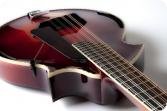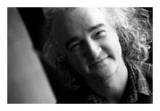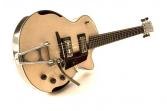Al Beardsell
Al Beardsell has been playing, repairing, and generally thinking about guitars for most of the past 25-30 years. The last 15 years have seen him building them professionally for genius musicians luminous and obscure alike, from Lou Reed of the Velvet Underground, to avant-garde musician and filmmaker Henry Kaiser, from local dudes the Weakerthans, to Quebecois noise/folk fusionist Rene Lussier.
His work has recently been featured in "The Fretboard Journal" (http://www.fretboardjournal.com/features/magazine/alternate-universe) and Acoustic Guitar Magazine (link).
He lives in Winnipeg, Manitoba, with his family, and likes to cook. He works amid a swirling miasma of wood, dust, shavings, smells and tools, in a small, chaotic, converted garage...called the Shed.
This is an excerpt of a presentation I gave at a PechaKucha event in Winnipeg, May 2010.
First, let me comment on the function of the guitar. It is a tool, a mechanism that turns creative impulses into sounds. It is at its core part drum and part symphony. Rhythm, melody, and harmony, all rolled into one package. The earliest incarnation would have resembled something that we know today as a banjo—a west african instrument that is part drum, part lyre, or harp—made from a gourd, animal skin, and wood. At some point, a couple thousand years ago it came north into the middle east and the skin was replaced by a wood soundboard, the gourd body with a wooden one and the al Oud ("of wood") was born. During the crusades this oud was brought to France, sinew frets were added and it became the Lute. Then the body shape went from the egg shape, to the hips and shoulders of the female form, and in the early 19th century the 6-string version we know today emerged. So you can see that all along the form has imitated shapes and ideas we see in nature.
O.K, so I was trying to talk about function and suddenly here i am talking about form! The two as I see it are inextricably linked – what fits the eye fits the hand, what fits the hand, fits the ear. The musician requires the smoothest path to expression, and as a tool of that expression, the instrument should not fight that. This is what I sometime refer to as "transparent interface"—how ideas become sounds with the least possible effort or discomfort.To that end I have incorporated a number of ergonomic elements—the armrest bevel on the lower bout, the way the cutaway moves into the heel, and the neck shaft that is asymmetrical to make it more comfortable for the hand. On a more functional level, I have taken the guitars' origins to heart by strengthening the rim to drum-like rigidity. This provides a more stable platform for the neck and soundboards--freer movement in the back and top, more volume and better projection. One of the biggest weaknesses in a guitar's design is that it is rather inefficient at turning energy into sound. Of the total energy produced by the vibrating string only about 6% is turned into sound. A lot of the energy is being absorbed or turned into heat... an increase of a percentage or two could mean a huge benefit in terms of the guitars volume and resonance. The sound ports on the side of the guitar help this as well. More importantly their bigger role is to allow the player a connection with the acoustic dynamics and character of the guitar in an amplified setting.
In an ensemble situation the guitar cannot compete in the same way a piano or the concert Harp can. In the case of the Harp the sound-holes are on the back... so I look to these instruments for inspiration.
To continue my comments on the form of the guitar, first let me acknowledge that if there is a traditional path of guitar making, I'm probably not on it. I use modern tools, materials and methods... and i would have no business without the internet and e-marketing. Since most of my clients are not local, I have to make a guitar that will pique the interest of a potential buyer without them even hearing or playing one—get them to visualize the all the cool music they would play on that guitar, perhaps after seeing it posted on my or a dealers web-site. There are certain shapes, curves, proportions that the eye can recognize, that tell a story. These shapes are all based on the constant phi, more commonly referred to as the Golden Mean, or Golden section. Like Pi its an irrational number that in its crudest form is 1.618.... but in nature it describes the spiral of a snails' shell, the swirl of a young fern, the cup of a lily, the proportion of the human body. To all you designers out there, I know this is nothing new. But, I think it could be said that the basis for traditional guitar design, and perhaps all instrument design, starts here—our world reflected in the curves, shapes, and proportions of guitars.
The innovation comes with the needs of the player—Most of the so called non-traditional design features of my instruments comes from a client bringing me ideas to improve the transparency of their interface with the instrument. Which is a pompous way of saying to personalize their musical tools. And it should be said that my clientele are themselves mainly Innovators-- in the Malcolm Gladwellian sense... and even some early adopters.
I see the traditional as an extension of the organic, in the same way that music and art are organic-- It evolves and moves with the people who make it, as a reflection of them selves and the world we live in.





